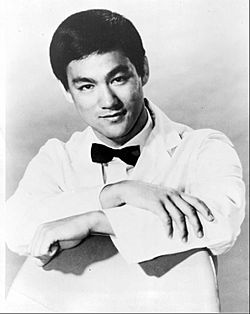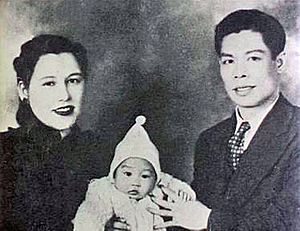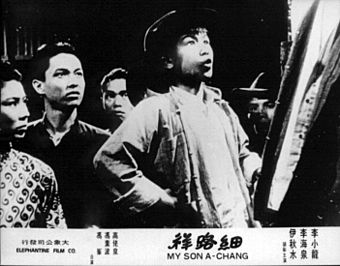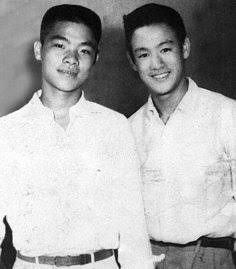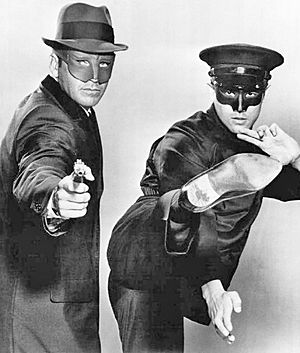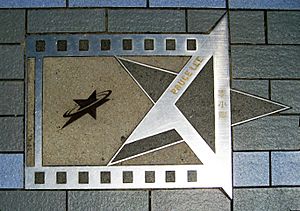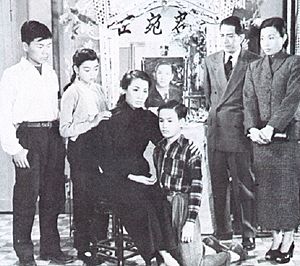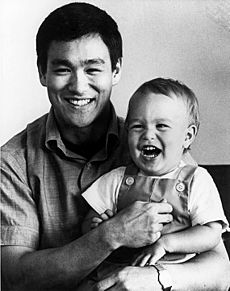Bruce Lee facts for kids
Quick facts for kids
Bruce Lee
|
|||||||||||
|---|---|---|---|---|---|---|---|---|---|---|---|
| 李小龍 | |||||||||||
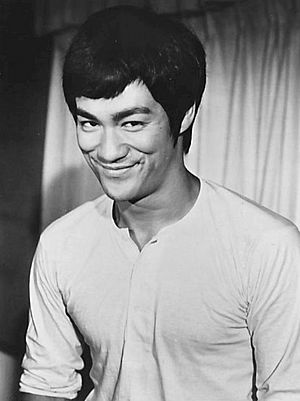
Lee in 1971
|
|||||||||||
| Born |
Lee Jun-fan (李振藩)
November 27, 1940 |
||||||||||
| Died | July 20, 1973 (aged 32) Kowloon Tong, British Hong Kong
|
||||||||||
| Cause of death | Cerebral edema | ||||||||||
| Resting place | Lake View Cemetery, Seattle, Washington, U.S. | ||||||||||
| Other names | Lee Siu-lung, Lee Yuen-cham, Lee Yuen-kam | ||||||||||
| Citizenship |
|
||||||||||
| Alma mater | University of Washington | ||||||||||
| Occupation |
|
||||||||||
| Years active | 1941–1973 | ||||||||||
| Spouse(s) | |||||||||||
| Children | Brandon and Shannon Lee | ||||||||||
| Parents |
|
||||||||||
| Relatives |
|
||||||||||
| Chinese name | |||||||||||
| Traditional Chinese | 李小龍 | ||||||||||
| Simplified Chinese | 李小龙 | ||||||||||
| Jyutping | Lei5 Siu2-lung4 | ||||||||||
|
|||||||||||
| Lee Jun-fan | |||||||||||
| Chinese | 李振藩 | ||||||||||
| Jyutping | Lei5 Zan3-faan4 | ||||||||||
|
|||||||||||
| Signature | |||||||||||
Bruce Lee (November 27, 1940 - July 20, 1973) was a Chinese American, Hong Kong actor, martial artist, martial arts instructor, philosopher, movie director, movie producer, screenwriter, and founder of the Jeet Kune Do martial arts movement.
Lee is famous for making martial arts popular in the United States in the 1970s, when he played in a series of movies. This included the first ever martial arts movie in the United States - called Enter the Dragon. This was the most successful and famous, which was released after Bruce's death. He died in 1973 during the production of a movie called, The Game of Death. The movie was not finished, although some completed section were later released. Almost 20 years later his son, Brandon Lee would also die while making a movie. Lee also taught other people martial arts, including actors Huggo Chairres, Steve McQueen, James Coburn, and basketball player Kareem Abdul-Jabbar. He inspired many other actors who are famous for using martial arts in their movies including Jackie Chan, Jet Li, and Chuck Norris. Jackie Chan had a small part in 'Enter The Dragon' and Chuck Norris co-starred in Way of The Dragon.
Lee starred in five movies, including The Big Boss, Fist of Fury (also known as The Chinese Connection and The Iron Hand), The Way of the Dragon (also known as Return of the Dragon), Enter the Dragon and The Game of Death.
He is noted for his major contributions to both the Hong Kong and American movie industry during the 1970s, his martial arts movement and innovative ideas (including Jeet Kune Do), his philosophy, and his physical fitness ability. He is considered to be a cultural icon and is considered to be one of the most influential martial artists ever by social critics and other martial artists alike.
On the night of July 20, 1973, Lee aged 32, died at his home from cerebral edema, which is a buildup of fluid around the brain. This is believed to have been caused by a reaction to painkillers he was taking for a back injury.
Early life
Bruce Lee's father Lee Hoi-chuen was a famous Cantonese opera singer based in Hong Kong. In December 1939, his parents went to Chinatown, San Francisco in California for an international opera tour. He was born there on November 27, 1940, making him a dual Hong Kong and United States citizen by birth. At four months old (April 1941), the Lee family returned to Hong Kong. Soon after, the Lee family led an unexpected four-year hard life as Japan, in the midst of World War II, launched a surprise attack of Hong Kong in December 1941 and ruled for four years.
Bruce's father, Lee Hoi-chuen, was Cantonese, and his mother, Grace Ho, was of Eurasian ancestry. Lee's maternal grandfather was Cantonese, his maternal grandmother was English and his maternal great-uncle, Robert Hotung, was a successful Hong Kong businessman of Dutch Jewish and Cantonese descent.
Career and education
1940–1958: Early roles, schooling and martial arts initiation
Lee's father Lee Hoi-chuen was a famous Cantonese opera star. As a result, the junior Lee was introduced to the world of cinema at a very young age and appeared in several films as a child. Lee had his first role as a baby who was carried onto the stage in the film Golden Gate Girl. He took his Chinese stage name as 李小龍, lit. Lee the Little Dragon, for the fact that he was born in both the hour and the year of the Dragon by the Chinese zodiac.
As a nine-year-old, he would co-star with his father in The Kid in 1950, which was based on a comic book character and was his first leading role. By the time he was 18, he had appeared in twenty films.
After attending Tak Sun School (德信學校; several blocks from his home at 218 Nathan Road, Kowloon), Lee entered the primary school division of the Catholic La Salle College at the age of 12.
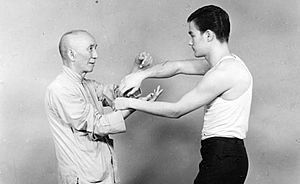
In 1956, due to poor academic performance and possibly poor conduct, he was transferred to St. Francis Xavier's College, where he would be mentored by Brother Edward, a teacher and coach of the school boxing team. After Lee was involved in several street fights, his parents decided that he needed to be trained in the martial arts. Lee's friend William Cheung introduced him to Ip Man but he was rejected from learning Wing Chun Kung Fu under him because of the long-standing rule in the Chinese Martial Arts world not to teach foreigners. His one quarter German background from his mother's side would be an initial obstacle towards his Wing Chun training; however, Cheung would speak on his behalf and Lee was accepted into the school. Lee began training in Wing Chun with Yip Man. Yip tried to keep his students from fighting in the street gangs of Hong Kong by encouraging them to fight in organised competitions. After a year into his Wing Chun training, most of Yip Man's other students refused to train with Lee when they had learned of his mixed ancestry, as the Chinese were generally against teaching their martial arts techniques to non-Asians. Lee's sparring partner, Hawkins Cheung, states, "Probably fewer than six people in the whole Wing Chun clan were personally taught, or even partly taught, by Yip Man". However, Lee showed a keen interest in Wing Chun and continued to train privately with Yip Man, William Cheung and Wong Shun-leung.
In 1958, Bruce won the Hong Kong schools boxing tournament, knocking out the previous champion, Gary Elms, in the final. That year, Lee was also a cha-cha dancer, winning Hong Kong's Crown Colony Cha-Cha Championship.
1959–1964: Continuous studies and martial arts breakthrough
In April 1959, Lee's parents decided to send him to the United States to stay with his older sister, Agnes Lee (李秋鳳), who was already living with family friends in San Francisco. After several months, he moved to Seattle in 1959 to continue his high school education, where he also worked for Ruby Chow as a live-in waiter at her restaurant. Chow's husband was a co-worker and friend of Lee's father. Lee's elder brother Peter Lee (李忠琛) would also join him in Seattle for a short stay before moving on to Minnesota to attend college. That year Lee also started to teach martial arts. He called what he taught Jun Fan Gung Fu (literally Bruce Lee's Kung Fu). It was basically his approach to Wing Chun. Lee completed his high school education and received his diploma from Edison Technical School on Capitol Hill in Seattle.
In March 1961, Lee enrolled at the University of Washington and studied dramatic arts, philosophy, psychology, and various other subjects. Lee dropped out of college in early 1964 and moved to Oakland to live with James Yimm Lee. James Lee was twenty years senior to Bruce Lee and a well-known Chinese martial artist in the area. Together, they founded the second Jun Fan martial arts studio in Oakland. James Lee was also responsible for introducing Bruce Lee to Ed Parker, an American martial artist. At the invitation of Parker, Lee appeared in the 1964 Long Beach International Karate Championships and performed repetitions of two-finger push-ups (using the thumb and the index finger of one hand) with feet at approximately shoulder-width apart.
1966–1970: American roles and creating Jeet Kune Do
From 1966 to 1967, Lee played the role of Kato alongside the title character played by Van Williams in the TV series produced and narrated by William Dozier titled The Green Hornet, based on the radio show by the same name. The show lasted only one season (26 episodes) from September 1966 to March 1967. Lee and Williams also appeared as their characters in three crossover episodes of Batman, another William Dozier-produced television series.
The Green Hornet introduced the adult Bruce Lee to an American audience, and became the first popular American show presenting Asian-style martial arts. The show's director wanted Lee to fight in the typical American style using fists and punches. As a professional martial artist, Lee refused, insisting that he should fight in the style of his expertise. At first, Lee moved so fast that his movements could not be caught on film, so he had to slow them down. After the show was cancelled in 1967, Lee wrote to Dozier thanking him for starting "my career in show business".
In 1967, Lee played a role in one episode of Ironside.
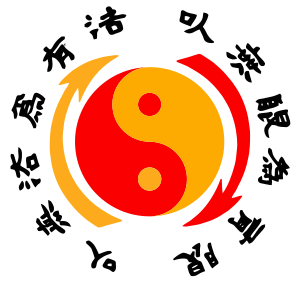
Jeet Kune Do originated in 1967. After filming one season of The Green Hornet, Lee found himself out of work and opened The Jun Fan Gung Fu Institute.
Lee decided to develop a system with an emphasis on "practicality, flexibility, speed, and efficiency". He started to use different methods of training such as weight training for strength, running for endurance, stretching for flexibility, and many others which he constantly adapted, including fencing and basic boxing techniques.
Lee emphasised what he called "the style of no style". This consisted of getting rid of the formalised approach which Lee claimed was indicative of traditional styles. Lee felt that even the system he now called Jun Fan Gung Fu was too restrictive, and it eventually evolved into a philosophy and martial art he would come to call Jeet Kune Do or the Way of the Intercepting Fist. It is a term he would later regret, because Jeet Kune Do implied specific parameters that styles connote, whereas the idea of his martial art was to exist outside of parameters and limitations. In 1969, Lee made a brief appearance in the Silliphant-penned film Marlowe.The same year, he was credited as the karate advisor in The Wrecking Crew, the fourth instalment of the Matt Helm comedy spy-fi film starring Dean Martin. Also that year, Lee acted in one episode of Here Come the Brides and Blondie.
In 1970, he was responsible for fight choreography for A Walk in the Spring Rain starring Ingrid Bergman and Anthony Quinn, again written by Silliphant.
1971–1973: Hong Kong films and Hollywood breakthrough
In 1971, Lee appeared in four episodes of the television series Longstreet, written by Silliphant. Lee played Li Tsung the martial arts instructor of the title character Mike Longstreet (played by James Franciscus), and important aspects of his martial arts philosophy were written into the script. According to statements made by Lee, and also by Linda Lee Cadwell after Lee's death, in 1971 Lee pitched a television series of his own tentatively titled The Warrior, discussions of which were also confirmed by Warner Bros. During a December 9, 1971, television interview on The Pierre Berton Show, Lee stated that both Paramount and Warner Brothers wanted him "to be in a modernized type of a thing, and that they think the Western idea is out, whereas I want to do the Western". According to Cadwell, however, Lee's concept was retooled and renamed Kung Fu, but Warner Bros. gave Lee no credit. Warner Brothers states that they had for some time been developing an identical concept, created by two writers and producers, Ed Spielman and Howard Friedlander in 1969, as stated too by Lee's biographer Matthew Polly. According to these sources, the reason Lee was not cast was because he had a thick accent, but Fred Weintraub attributes that to his ethnicity. The role of the Shaolin monk in the Wild West was eventually awarded to then-non-martial-artist David Carradine. In The Pierre Berton Show interview, Lee stated he understood Warner Brothers' attitudes towards casting in the series: "They think that business-wise it is a risk. I don't blame them. If the situation were reversed, and an American star were to come to Hong Kong, and I was the man with the money, I would have my own concerns as to whether the acceptance would be there".
Producer Fred Weintraub had advised Lee to return to Hong Kong and make a feature film which he could showcase to executives in Hollywood. Not happy with his supporting roles in the US, Lee returned to Hong Kong. Unaware that The Green Hornet had been played to success in Hong Kong and was unofficially referred to as "The Kato Show", he was surprised to be recognised as the star of the show. After negotiating with both Shaw Brothers Studio and Golden Harvest, Lee signed a film contract to star in two films produced by Golden Harvest.
Lee played his first leading role in The Big Boss (1971), which proved to be an enormous box office success across Asia and catapulted him to stardom. He soon followed up with Fist of Fury (1972), which broke the box office records set previously by The Big Boss. Having finished his initial two-year contract, Lee negotiated a new deal with Golden Harvest. Lee later formed his own company, Concord Production Inc., with Chow. For his third film, Way of the Dragon (1972), he was given complete control of the film's production as the writer, director, star, and choreographer of the fight scenes. In 1964, at a demonstration in Long Beach, California, Lee met karate champion Chuck Norris. In Way of the Dragon Lee introduced Norris to moviegoers as his opponent, their showdown has been characterised as "one of the best fight scenes in martial arts and film history". The role had originally been offered to American karate champion Joe Lewis. Fist of Fury and Way of the Dragon went on to gross an estimated US$100 million and US$130 million worldwide, respectively.
From August to October 1972, Lee began work on his fourth Golden Harvest film Game of Death. He began filming some scenes, including his fight sequence with 7 ft 2 in (218 cm) American basketball star Kareem Abdul-Jabbar, a former student. Production stopped in November 1972 when Warner Brothers offered Lee the opportunity to star in Enter the Dragon, the first film to be produced jointly by Concord, Golden Harvest, and Warner Bros. Filming began in Hong Kong in February 1973 and was completed in April 1973. One month into the filming, another production company, Starseas Motion Pictures, promoted Bruce Lee as a leading actor in Fist of Unicorn, although he had merely agreed to choreograph the fight sequences in the film as a favour to his long-time friend Unicorn Chan. Lee planned to sue the production company, but retained his friendship with Chan. However, only a few months after the completion of Enter the Dragon, and six days before its July 26, 1973, release, Lee died. Enter the Dragon would go on to become one of the year's highest-grossing films and cement Lee as a martial arts legend. It was made for US$850,000 in 1973 (equivalent to $4 million adjusted for inflation as of 2007). Enter the Dragon is estimated to have grossed over $400 million worldwide, estimated to be the equivalent of over $2 billion adjusted for inflation as of 2022[update]. The film sparked a brief fad in martial arts, epitomised in songs such as "Kung Fu Fighting" and some TV shows.
1978–present: Posthumous work
Robert Clouse, the director of Enter the Dragon, together with Golden Harvest, revived Lee's unfinished film Game of Death. Lee had shot over 100 minutes of footage, including out-takes, for Game of Death before shooting was stopped to allow him to work on Enter the Dragon. In addition to Abdul-Jabbar, George Lazenby, Hapkido master Ji Han-Jae, and another of Lee's students, Dan Inosanto, were also to appear in the film, which was to culminate in Lee's character, Hai Tien (clad in the now-famous yellow track suit) taking on a series of different challengers on each floor as they make their way through a five-level pagoda. In a controversial move, Robert Clouse finished the film using a look-alike and archive footage of Lee from his other films with a new storyline and cast, which was released in 1978. However, the cobbled-together film contained only fifteen minutes of actual footage of Lee (he had printed many unsuccessful takes) while the rest had a Lee look-alike, Kim Tai Chung, and Yuen Biao as stunt double. The unused footage Lee had filmed was recovered 22 years later and included in the documentary Bruce Lee: A Warrior's Journey.

Apart from Game of Death, other future film projects were planned to feature Lee at the time. In 1972, after the success of The Big Boss and Fist of Fury, a third film was planned by Raymond Chow at Golden Harvest to be directed by Lo Wei, titled Yellow-Faced Tiger. However, at the time, Lee decided to direct and produce his own script for Way of the Dragon instead. Although Lee had formed a production company with Raymond Chow, a period film was also planned from September–November 1973 with the competing Shaw Brothers Studio, to be directed by either Chor Yuen or Cheng Kang, and written by Yi Kang and Chang Cheh, titled The Seven Sons of the Jade Dragon.
In 2015, Perfect Storm Entertainment and Bruce Lee's daughter, Shannon Lee, announced that the series The Warrior would be produced and would air on the Cinemax and filmmaker Justin Lin was chosen to direct the series. Production began on October 22, 2017, in Cape Town, South Africa. The first season will contain 10 episodes. In April 2019, Cinemax renewed the series for a second season.
On March 25, 2021, it was announced that producer Jason Kothari has acquired the rights to The Silent of Flute "to become a miniseries, which will have John Fusco as a screenwriter and executive producer.
Personal life
Names
Lee's Cantonese birth name was Lee Jun-fan (李振藩). The name homophonically means "return again", and was given to Lee by his mother, who felt he would return to the United States once he came of age. Because of his mother's superstitious nature, she had originally named him Sai-fon (細鳳), which is a feminine name meaning "small phoenix". The English name "Bruce" is thought to have been given by the hospital attending physician, Dr. Mary Glover.
Lee had three other Chinese names: Lee Yuen-cham (李源鑫), a family/clan name; Lee Yuen-kam (李元鑒), which he used as a student name while he was attending La Salle College, and his Chinese screen name Lee Siu-lung (李小龍; Siu-lung means "little dragon"). Lee's given name Jun-fan was originally written in Chinese as 震藩; however, the Jun (震) Chinese character was identical to part of his grandfather's name, Lee Jun-biu (李震彪). Hence, the Chinese character for Jun in Lee's name was changed to the homonym 振 instead, to avoid naming taboo in Chinese tradition.
Family
Lee's father, Lee Hoi-chuen, was one of the leading Cantonese opera and film actors at the time and was embarking on a year-long opera tour with his family on the eve of the Japanese invasion of Hong Kong. Lee Hoi-chuen had been touring the United States for many years and performing in numerous Chinese communities there.
Although many of his peers decided to stay in the US, Lee Hoi-chuen returned to Hong Kong after Bruce's birth. Within months, Hong Kong was invaded and the Lees lived for three years and eight months under Japanese occupation. After the war ended, Lee Hoi-chuen resumed his acting career and became a more popular actor during Hong Kong's rebuilding years.
Lee's mother, Grace Ho, was from one of the wealthiest and most powerful clans in Hong Kong, the Ho-tungs. She was the half-niece of Sir Robert Ho-tung, the Eurasian patriarch of the clan. As such, the young Bruce Lee grew up in an affluent and privileged environment. Despite the advantage of his family's status, the neighbourhood in which Lee grew up became overcrowded, dangerous, and full of gang rivalries due to an influx of refugees fleeing communist China for Hong Kong, at that time a British Crown Colony.
Grace Ho is reported as either the adopted or biological daughter of Ho Kom-tong (Ho Gumtong, 何甘棠) and the half-niece of Sir Robert Ho-tung, both notable Hong Kong businessmen and philanthropists. Bruce was the fourth of five children: Phoebe Lee (李秋源), Agnes Lee (李秋鳳), Peter Lee, and Robert Lee.
Grace's parentage remains unclear. Linda Lee, in her 1989 biography The Bruce Lee Story, suggests that Grace had a German father and was a Catholic. Bruce Thomas, in his influential 1994 biography Bruce Lee: Fighting Spirit, suggests that Grace had a Chinese mother and a German father. Lee's relative Eric Peter Ho, in his 2010 book Tracing My Children's Lineage, suggests that Grace was born in Shanghai to a Eurasian woman named Cheung King-sin. Eric Peter Ho said that Grace Lee was the daughter of a mixed race Shanghainese woman and her father was Ho Kom Tong. Grace Lee said her mother was English and her father was Chinese. Fredda Dudley Balling said Grace Lee was three-quarters Chinese and one-quarter British.
In the 2018 biography Bruce Lee: A Life, Matthew Polly identifies Lee's maternal grandfather as Ho Kom-tong, who had often been reported as his adoptive grandfather. Ho Kom-tong's father, Charles Maurice Bosman, was a Dutch Jewish businessman from Rotterdam. He moved to Hong Kong with the Dutch East India Company and served as the Dutch consul to Hong Kong at one time. He had a Chinese concubine named Sze Tai with whom he had six children, including Ho Kom Tong. Bosman subsequently abandoned his family and immigrated to California. Ho Kom Tong became a wealthy businessman with a wife, 13 concubines, and a British mistress who gave birth to Grace Ho.
His younger brother Robert Lee Jun-fai is a notable musician and singer, his group The Thunderbirds were famous in Hong Kong. A few singles were sung mostly or all in English. Also released was Lee singing a duet with Irene Ryder. Lee Jun-fai lived with Lee in Los Angeles in the United States and stayed. After Lee's death, Lee Jun-fai released an album and the single by the same name dedicated to Lee called The Ballad of Bruce Lee. While studying at the University of Washington he met his future wife Linda Emery, a fellow student studying to become a teacher. As relations between people of different races was still banned in many US states, they married in secret in August 1964. Lee had two children with Linda: Brandon (1965–1993) and Shannon Lee (born 1969). Upon's Lee passing in 1973, she continued to promote Bruce Lee's martial art Jeet Kune Do. She wrote the 1975 book Bruce Lee: The Man Only I Knew, on which the 1993 feature film Dragon: The Bruce Lee Story was based. In 1989, she wrote the book The Bruce Lee Story. She retired in 2001 from the family estate.
Lee died when his son Brandon was eight years old. While alive, Lee taught Brandon martial arts and would invite him to visit sets. This gave Brandon the desire to act and went on to study the craft. As a young adult, Brandon Lee found some success acting in action-oriented pictures such as Legacy of Rage (1986), Showdown in Little Tokyo (1991), and Rapid Fire (1992). In 1993, at the age of 28, Brandon Lee died after being accidentally shot by a prop gun on the set of The Crow.
Lee died when his daughter Shannon was four. In her youth she studied Jeet Kune Do under Richard Bustillo, one of her father's students; however, her serious studies did not begin until the late 1990s. To train for parts in action movies, she studied Jeet Kune Do with Ted Wong.
Images for kids
See also
 In Spanish: Bruce Lee para niños
In Spanish: Bruce Lee para niños


